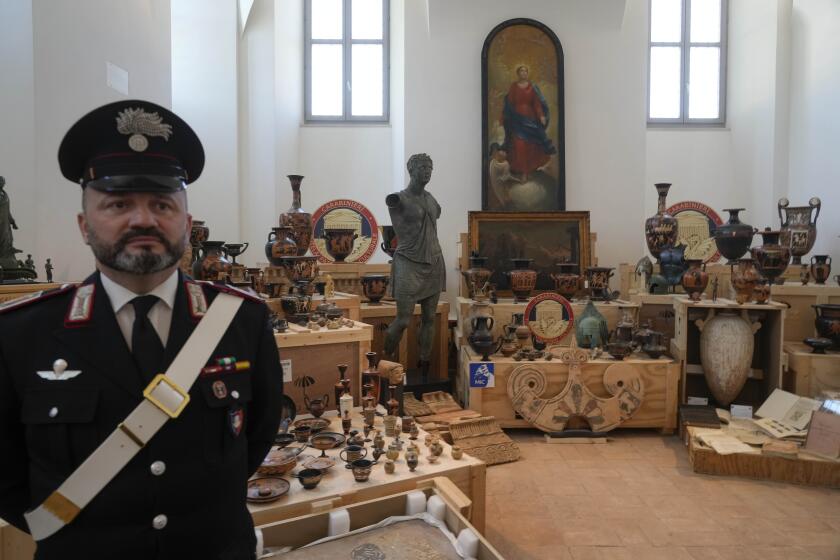WEST MEXICO FUNERARY ITEMS TO GO ON VIEW
Nearly 2,000 years ago on the Pacific coast of Mexico thrived cultures that--as have other primitive peoples through time--buried their dead with objects today often prized both as artworks and as clues to understanding ancient civilizations.
Little is known about these prehistoric inhabitants of present-day Nayarit, Jalisco and Colima--states of west Mexico--and cemetery excavations are infrequent. But a new installation of 80 pre-Columbian funerary sculptures and vessels, recently acquired by the County Museum of Art, has helped expand the limited body of knowledge.
This Proctor Stafford Collection, on permanent view starting Wednesday, comprises dramatic standing and attacking warriors, a kneeling woman, a wrestler, a hunchback and other richly colored, finely modeled terra cotta pieces in human, animal and plant forms found in subterranean tombs dug into volcanic rocks.
Stafford, an art collector and investor, initially loaned his sculptures to the museum for exhibit in 1970. Since then, the collection has been often referred to as a “textbook” collection, said museum curator Constantina Oldknow, because of its excellent quality, because it was one of the first of its kind accessible for study and because a “landmark” scholarly catalogue, still quoted by experts discussing west Mexican ceramics, accompanied the display.
“Stafford’s collection is distinguished by the dynamism of the individual pieces; the overall high quality of their preservation,” Oldknow said. “And he has a lot of unusual pieces in addition to excellent examples of well-known (west Mexican ceramic) types.” Stafford’s unique pieces “add to the overall understanding of these (west Mexican) cultures,” she added.
Stafford, who now divides his time between California and Hawaii, began collecting the ceramic sculptures before he moved to Mexico for five years in the mid-1950s.
“My point of view has been the aesthetic,” Stafford said. “My mission with my collection has been to show to the world that these wonderful sculptures are indeed fine art, and hence my great affection and my great sense of accomplishment in the fact that the County Museum of Art has acquired the collection.”
GRANTS OFFERED: The locally based Lannan Foundation, planning to disburse about $1 million to about 20 art institutions nationwide in 1988, is soliciting grant applications as it enters the first fully operational year of its visual arts grants program.
The foundation, endowed last year with $100 million from the estate of financier and art collector J. Patrick Lannan, is required to spend 5% of its total assets annually. Its focus is on contemporary art and its aim is to support and bring greater recognition to “emerging and under-recognized artists” of today, said Bonnie Clearwater, the foundation’s director.
The foundation is especially interested in grant proposals from institutions that:
--Feature the work of emerging or under-recognized living artists.
--Give established contemporary artists exposure in locales where their work has not been represented.
--Feature and interpret institutions’ own collections of contemporary art.
--Provide a forum for work that is unlikely to be sponsored because it is too controversial or experimental.
Funding from the foundation’s visual arts grants program is available to institutions for solo and group exhibitions, exhibition series, temporary installations (including site-specific works) and interdisciplinary activities.
Grants will not awarded to individuals; for general operating expenses or endowment funds; for juried exhibitions, annuals, biennials and internationals or maintenance and conservation of sponsored projects and commissions.
The foundation will review grant requests in this program three times a year, on the first day of October, February and May. Recipients are chosen by Clearwater and the foundation’s advisory committee of Gifford Phillips, chairman; John Elderfield, a curator at New York’s Museum of Modern Art, and Christopher Knight, art critic for the Los Angeles Herald Examiner.
Southern California audiences, artists and art institutions have already enjoyed the largess of the Lannan Foundation. This year and last, Lannan grants totaling $857,742 were given to 12 institutions nationwide. Among them were the Newport Harbor Art Museum and Santa Barbara’s University Art Museum for organizing traveling exhibitions featuring the work of Chris Burden and Terry Winters, respectively.
In addition, the Museum of Contemporary Art is slated to host two traveling exhibits supported by Lannan grants. An Anselm Kiefer exhibition organized by the Art Institute of Chicago and Philadelphia Museum of Art will come to MOCA in 1988 and a show of Richard Artschwager’s work from New York’s Whitney Museum of American Art is scheduled for 1989.
To determine which institutions should receive grants, Lannan officials scrutinize how the funds will benefit recipient institutions, the careers of participating artists and the public’s art education.
Grant applications are available from Lannan Foundation, 12555 W. Jefferson Blvd., Suite 218, Los Angeles 90066.
The foundation also has a collection of contemporary art, exhibited at the modest Lannan Museum in Lake Worth, Fla., and on loan to other museums. Lannan also is developing a museum acquisition grant program and programs for publication, criticism, literature and poetry.
RECENT ACQUISITIONS: The J. Paul Getty Museum has added to its permanent holdings a stylized 18th-Century Meissen porcelain figurine and a tender genre painting by German realist Max Liebermann.
The white, hard-paste porcelain, by an unknown artist, portrays the roguish commedia dell’arte character Beltramo di Milano.
Liebermann’s oil, “Old Woman With Cat” (1878), shows the elderly lady cradling the contented feline and staring fondly into its eyes, while the cat meets her gaze with what seems to be reciprocal affection.
The Getty currently displays both works.
More to Read
Start your day right
Sign up for Essential California for news, features and recommendations from the L.A. Times and beyond in your inbox six days a week.
You may occasionally receive promotional content from the Los Angeles Times.






